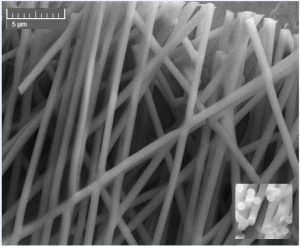Infrared-Pumped upconversion glass-ceramic nanorods for photonics applications
Project Director: Dr. Mihail SECU
National Institute of Materials Physics
In the present project we intend to use glass-ceramic technology in order to obtain obtain rare-earths doped LiYF4 glass-ceramics nanorods and to investigate their optical and up-conversion properties.
Glass ceramics technology is based on a controlled crystallization of a low phonon energy nanocrystalline phase embedded among the glassy matrix. During the heat treatment process, RE ions are selectively incorporated into the precipitated fluoride nanocrystals showing enhanced luminescence properties. Moreover, the material remains transparent because light scattering is avoided due to nano-scale size of the precipitated crystals.
The basic idea of the project is to combine the advantages of the sol-gel glass method (simplicity, ability to control the purity and homogeneity of the final materials on a molecular level, segregation of nanocrystals along with RE elements with predetermined concentration and size) with the waveguiding properties of the nanorods.
We choose YLiF4 as one of the most common rare earth-doped laser materials, with the largest number of laser lines from the UV to mid-IR range among fluoride crystals. LiYF4 glass-ceramics nanorods will be prepared by using the template method and nanoporous polycarbonate membranes, obtained by heavy ion irradiation and chemical etching; RE-doped gels will be prepared by using tetraethylorthosilicate (TEOS) as precursor and trifluoroacetic acid (TFA) as fluorine agent. Nanoporous polycarbonate membranes will be used as templates for “growing” RE-doped xerogels nanorods from the gel by using capillarity forces. Subsequent thermal annealing will produce the precipitation of the fluoride nanocrystals (YLiF4) with the size below 10nm and enhanced luminescence and up-conversion properties.
The research efforts will be concentrated on luminescence and up-conversion effects after doping with (Eu3+, Er3+-Yb3+ and Ho3+) and the way how are influenced by the preparative conditions as nanorods size, dopant concentration, nanocrystalline fraction.

The specific project objectives of the project are:
1. Preparation of the YLiF4 (YLiF) glass-ceramics nanorods and their structural characterization.
2. Influence of the preparative conditions (nanorods size, dopant concentration, nanocrystallized fraction in the glass) by using Eu3+-dopant ion as “sample probe”.
3. Investigation of the up-conversion properties of (Er3+-Yb3+) doped YLiF glass-ceramic nanorods and how they are influenced by the nanorods size (diameter and length).
4. Investigation of the avalanche mechanism for the up-conversion in Ho3+-doped YLiF glass-ceramic nanorods.
1. Dr. Secu Mihail (physicist) responsible with the management of the project and the optical/structural characterisations.
2. Dr. Secu Elisabeta Corina (physicist) responsible with the materials synthesis together with Toma Vasilica (technician).
3. Dr. Sima Marian (chemist) responsible with the electrochemical synthesis of the xerogel nano- and microrods.
4. Negrea (Damian) Raluca (physicist) responsible with the electron microscopy measurements (TEM/SEM)
5-6. Dr. Dinescu Maria (physicist) and Dr. Stokker-Cheregi Flavian (physicist) responsible with the activities related to the luminescence properties under infrared pumping and laser light excitation
7. Toma Vasilica (technician) involved in the samples synthesis
8. Damir Mladenovivi master student involved in all research activities.
Project Time table and activity reports results
2011. The gel filing process of the polycarbonate membranes pores
2012. Preparation and characterization of the Eu3+-YLiF4 (YLiF) glass-ceramics nanorods
2013. Optimization of the optical properties
2014. Optimization of the optical properties
2015. Investigation of the up-conversion properties of (Er3+-Yb3+) doped YLiF glass-ceramic nanorods
1. Damir Mladenovici - student inscris la masterat implicat in activitatile de cercetare
2012
1. "Sol-gel template synthesis of luminescent glass-ceramic rods"
M. Secu; C.E. Secu; M. Sima, J.. Nanoparticle Research 14:772 (2012), 10.1007/s11051-012-0772-1
2013
2. Luminescent Eosin Y–SiO2 hybrid nano and micro rods prepared by sol–gel template method;
M. Secu; C.E. Secu; M. Sima; R.F. Negrea; C. Bartha; M. Dinescu and V. Damian, Journal of Luminescence , vol.143 (2013) p.89-92, DOI: /10.1016/j.jlumin.2013.04.043
3. Ultraviolet and visible up-conversion luminescence of Er3+/Yb3+ co-doped CaF2 nanocrystals in sol–gel derived glass-ceramics
S. Georgescu; A.M. Voiculescu; C. Matei; C.E. Secu; R.F. Negrea; M. Secu; Journal of Luminescence ,vol. 143 (2013) p.150-156, DOI: 10.1016/j.jlumin.2013.04.002
4. Eu3+ probe ion for rare-earth dopant site structure in sol-gel derived LiYF4 oxyfluoride glass-ceramic
C.E. Secu, R.F. Negrea and M. Secu; Optical Materials, vol.35 (2013) p. 2456-2460 DOI: 10.1016/j.optmat.2013.06.053
2014
5. Photoluminescence of Eu3+-doped LiYF4 thin-films grwown by pulsed laser deposition and matrix-assisted pulsed laser deposition
F. Stokker-Cheregi, A. Matei, M. Dinescu, C. E. Secu, M. Secu, Journal of Physics D ( 2014) - J. Phys. D: Appl. Phys. 47 045304 DOI:10.1088/0022-3727/47/4/045304
6. Thermally activated conversion of a silicate gel to a oxyfluoride glass ceramic: optical study using Eu3+ probe ion
2015
7. Up-conversion luminescence of Er3+/Yb3+ co-doped LiYF4 nanocrystals in sol-gel derived glass-ceramics
M. Secu and C.E. Secu Journal of Non-Crystalline Solids. 426:78-82(2015) doi:10.1016/j.jnoncrysol.2015.07.010
8. Luminescence properties of Eu3+-doped SiO2-LiYF4 glass-ceramics microrods
C.E. Secu and M. Secu Optical Materials. 47:95-98 (2015) doi:10.1016/j.optmat.2015.07.009
9. Structural and optical properties of fluorescent of BaFBr-Eu@SiO2 core-shell phosphor heterostructure
M. Secu, C.E. Secu, M. Cernea, B.S. Vasile, Materials Chemistry and Physics vol.51 (2015) p. 81-86 doi:10.1016/j.matchemphys.2014.11.038
2016
10. Non-isothermal crystallization kinetics growth of LiYF4(Yb,Er) nanoparticles
C. Bartha, C.E. Secu, M. Secu Ceramics International, vol. 42, no.16, p. 18732-18736 (2016) doi.org/10.1016/j.ceramint.2016.09.012
11.Crystallization and luminescence properties of a new Eu3+-doped LaOCl nano-glass-ceramic
M. Secu C.E. Secu and C. Bartha Journal of the European Ceramic Society vol 36 no.1 p.203-207 doi.org/10.1016/j.jeurceramsoc.2015.09.001
12. Up-conversion luminescence of BaCl2:Er3+ nanocrystals embedded in oxychloride nano-glass ceramic
M. Secu C.E. Secu and C. Bartha Journal of the European Ceramic Society vol 36 no.1 p.1699-1703 doi.org/10.1016/j.jeurceramsoc.2016.01.016
13. Sol-gel template assisted synthesis and up-convesrion properties of (Yb-Er) doped SiO2-LiYF4 glass-ceramic rods
C.E. Secu and E. Matei Digest Journal of Nanomaterials and Biostructures Vol. 11, No. 2, p. 489 - 494 (2016)
14. Laser processing of Yb3+/Er3+ co-doped LiYF4 thin films with up-conversion properties
C. E. Secu, M. Secu, F. Stokker-Cheregi, V. Ion, S. Brajnicov and M. Dinescu (under review at Thin Solids Films journal (2016)
Conferences:
Dr,. Mihail SECU
National Institute of Materials Physics
Laboratory of Optical Processes in Nanostructured Materials,
tel: +040 213690185 /161
PROJECTS/ NATIONAL PROJECTS
Copyright © 2025 National Institute of Materials Physics. All Rights Reserved